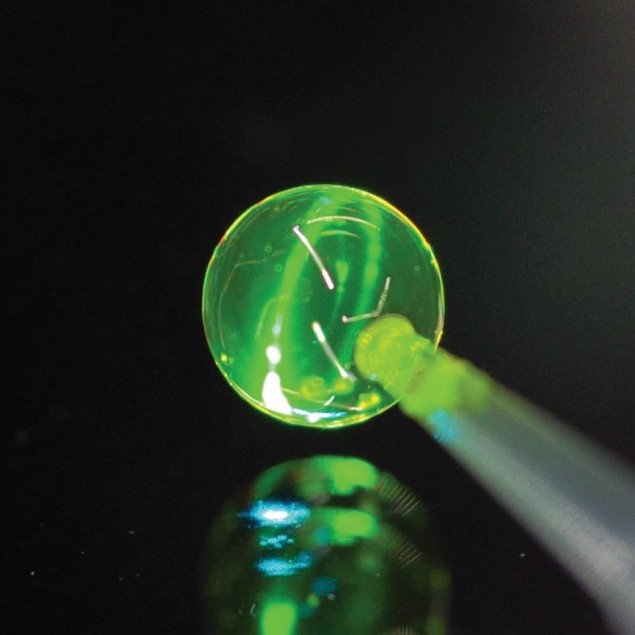
Soap has long been a household staple, but scientists in Slovenia have now found a new use for it by transforming soap bubbles into tiny lasers. Working at the Jožef Stefan Institute and the University of Ljubljana, they began by creating soap bubbles a few millimetres in diameter. When they mixed these with a fluorescent dye and pumped them with a pulsed laser, the bubbles began to lase. The wavelengths of light the bubble emits are highly responsive to its size, paving the way for bubble-laser sensors that can detect tiny changes in pressure or ambient electric field.
A laser requires three key components: a gain medium, an energy source for the gain medium and an optical resonator. The gain medium amplifies the light, meaning that for every photon that goes into the gain medium, more than one photon comes out. This phenomenon can be exploited by placing the gain medium in a resonator – for example, between two mirrors or inside a loop – such that the photons emitted by the gain medium go back through it to create an amplified, coherent beam of light.
The soap-bubble lasers do exactly that. To make them, Matjaž Humar and Zala Korenjak mixed standard soap solution with fluorescent dye, which acts as the gain medium. The bubbles form at the end of a capillary tube, and illuminating them with a pulsed laser pumps the gain medium. The light the gain medium produces circulates along the surface of the bubble, which acts as a resonator.
To characterize the bubble’s output, the researchers used a spectrometer to measure the wavelengths of light it produces. Only after the system reaches a threshold pumping energy do the researchers see peaks in the bubble’s wavelength spectrum – a key marker of lasing.
From St Paul’s Cathedral to the surface of a soap bubble
Forming a resonator out of a sphere is not, in itself, new. Micro-cavities formed in spheres, rings and toroids have all found uses in sensing, and are known as whispering gallery mode resonators after the famous whispering gallery at St Paul’s Cathedral in London. Within this large, circular room, two people who stand facing the wall on opposite sides can hear each other even at a whisper thanks to the efficient guiding of sound waves along the room’s curved walls.

In much the same way, Humar and Korenjak found that light propagates along the surface of the soap bubble in their laser, and appears as a bright band on the bubble’s shell. As the light travels around the surface of the bubble, it interferes, creating distinct “modes” of the resonator. These modes show up as a series of regularly spaced peaks in the wavelength spectrum of the bubble.

Don’t burst my bubble
“There are many micro-resonators used as laser cavities, including solid spherical shells,” Matjaž notes. “Soap bubbles, however, have not been studied as optical cavities until now.”
This may be partly because bubble lasers made of soap have limited practicality. As water evaporates from the surface of the bubble, the bubble’s thickness changes rapidly until it pops.
A more practical solution the researchers pursued is to make bubbles out of smectic liquid crystals. These do not contain water and can form very thin bubbles, typically around 30-120 nanometres (nm) thick. These smectic bubble lasers are more stable and can survive almost indefinitely. As Matjaž explains, thicker bubbles (such as those created by soap), allow many modes in the resonator, resulting in many, possibly overlapping peaks in the wavelength spectrum. Thinner bubbles (less than 200 nm), however, allow only one mode in the resonator. This single-mode operation manifests as evenly distributed peaks in the lasing spectra.

Light waves steer electron beams thanks to whispering gallery effect
The researchers demonstrated that the wavelength the bubble lasers emitted could be tuned by altering their environment. Specifically, changing the ambient pressures or electric fields altered the size of the bubble, which changes the size of the resonator and, in turn, the wavelength of the laser emission. The measurements they present show that the smectic bubble lasers are sensitive to electric fields as small as 0.35V/mm and pressure changes of 0.024 Pa – on par or better than some existing sensors.
The pair describe their work in Physical Review X.
- SEO Powered Content & PR Distribution. Get Amplified Today.
- PlatoData.Network Vertical Generative Ai. Empower Yourself. Access Here.
- PlatoAiStream. Web3 Intelligence. Knowledge Amplified. Access Here.
- PlatoESG. Carbon, CleanTech, Energy, Environment, Solar, Waste Management. Access Here.
- PlatoHealth. Biotech and Clinical Trials Intelligence. Access Here.
- Source: https://physicsworld.com/a/soap-bubbles-transform-into-lasers/



